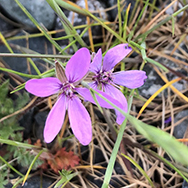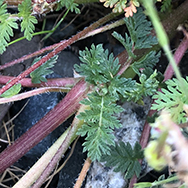|
|
|
|
|
|
| Practical ecological knowledge for the temperate reader. |
Erodium cicutarium - Common stork's-bill
Family: Geraniaceae (Geranium) [E-flora]
Subtaxa Present in B.C.
- Erodium cicutarium ssp. cicutarium [E-flora]
"Erodium cicutarium is a ANNUAL growing to 0.6 m (2ft). It is in flower from June to September, and the seeds ripen from August to October. The species is hermaphrodite (has both male and female organs) and is pollinated by Bees, beetles, Lepidoptera (Moths & Butterflies). The plant is self-fertile. Suitable for: light (sandy), medium (loamy) and heavy (clay) soils and prefers well-drained soil. Suitable pH: neutral and basic (alkaline) soils and can grow in very alkaline soils.
It cannot grow in the shade. It prefers moist soil. The plant can tolerate maritime exposure." [PFAF]
Origin Status: Exotic [E-flora]
"General: Annual herb from a taproot; stems decumbent to erect, spreading-hairy, reddish with swollen nodes, 3-40 cm tall." [IFBC-E-flora]
"Leaves: Basal leaves pinnately divided with narrow incised segments, oblong in outline, stiff-hairy, 3-10 cm long; stem leaves similar, few, opposite, reduced upwards; stipules abruptly pointed." [IFBC-E-flora]
"Flowers: Inflorescence of few, small, axillary, umbrella-shaped clusters of flowers; petals pink to purple, sometimes whitish, 3-8 mm long, the claw fringed with long hairs; sepals slightly shorter than the petals, bristle-tipped to awned with a fringed claw." [IFBC-E-flora]
"Fruits: Carpels, spindle-shaped, sharp-pointed at the base; styles long-beaked, 3-4 cm long, twisting at maturity; seeds 1 per segment, glabrous." [IFBC-E-flora]
Habitat / Range
"Mesic to dry fields, woodlands and waste places in the lowland, steppe and montane zones; common in SW and SC BC; introduced from Eurasia." [IFBC-E-flora]
"Europe, including Britain, from Norway south and east to N. Africa, the Himalayas and Japan" [PFAF]
"Filaree (Erodium circutarium and moschatum) prefers disturbed areas such as soil that has been recently cleared. It is also found in fields and lawns. The plant is native to the Mediterranean region."[Nyerges]
Edible Uses
- Young Plant: - Raw or cooked. Used as a salad, boiled for greens.. This plant, when young, is gathered and cooked, or eaten raw by the Blackfeet, Shoshone and Digger Indians. Fremont saw it thus used, and R. Brown says it is the pin grass of the Californians of which the stem is edible. [Sturtevant EPW]
- Young Leaves: "Young leaves - raw or cooked as a potherb[2, 62, 84, 85, 183]. Harvested in the spring before the plant flowers[257], they are tasty and nutritious[207]. The leaves are added to salads, sandwiches, soups etc[9], they can be used in recipes that call for leaves of beet, plantain, sow thistle or amaranth[183]." [PFAF] "This species has been used when young, either raw or cooked. It can be used as a salad, worked in to good advantage with other plants like lettuce. If you boil it for greens, we suggest that you select young tender parts and try boiling them for about 25 minutes (at 5000 ft.)." [Harrington] "The green leaves, though slightly fibrous, can be eaten raw in salads, the small coarse hairs requiring some extra mastication to ensure digestion. They can also be cooked like spinach, and provide spinachlike flavor." [Nyerges]
- Young Stems: -" Raw[257]." [PFAF] They are particularly palatable when picked young and have a parsleylike taste. We find it nicely complements an otherwise bland wild salad and provides a good source of vitamin K. [Vizgirdas WPSN] "The mild-flavored stems can be eaten raw." [Nyerges]
- Root - "Root - chewed by children as a gum[257]." [PFAF]
Other Uses
- Dye - "A green dye is obtained from the whole plant. It does not require a mordant[168]." [PFAF]
- Weather Indicator - "The remnants of the styles are very hygroscopic, they can be used in hygrometers and as weather indicators[46, 61]." [PFAF]
- Misc - "The dried plant powder has been mixed with watermelon seeds during storage and planting in order to prevent watermelon disease[257]." [PFAF]
- Fodder - "Kawaiisu Forage Plant eaten by horses, cows, and rabbits. (206:31) Navajo, Ramah Fodder Used for sheep feed. 091:34)" [NAEth]
Medicinal Uses
In the past the plant was widely used but its current use is limited (Khalmatov 1964 ).[Eisenman MPCA]
- Whole Plant -
- "The whole plant is astringent and haemostatic{9, 13, 21]. It has been used in the treatment of uterine and other bleeding[9]." [PFAF]
- "Externally, the plant has been used as a wash on animal bites, skin infections etc[257]." [PFAF]
- Aerial parts used for stomach ailments. [Rai EthPlants]
- In Iraq, a decoction of the whole plant is used for treatment of anasarca and metrorrhagia (Al-douri 2000 ). [Eisenman MPCA]
- In Turkey, a decoction of the whole plant is used externally to treat pains (Simsek et al. 2004 ). [Eisenman MPCA]
- Preparation: Select young tender parts and try boiling them for about 25 minutes (at 5000 ft.). This plant was much used by certain Indian tribes. It is abundant in some seasons in some localities, often present in large quantity early in the season, just when other foods may be scarce.
- Root & Leaves - "The root and leaves have been eaten by nursing mothers to increase the flow of milk[257]." [PFAF]
- Root - "A poultice of the chewed root has been applied to sores and rashes[257]." [PFAF]
- Leaves - "A tea made from the leaves is diaphoretic and diuretic[222]. An infusion has been used in the treatment of typhoid fever[257]. The leaves are soaked in bath water for the treatment of rheumatism[222]." [PFAF] Leaves were also used in a hot tea to increase urine flow and to increase perspiration. [Vizgirdas WPSN]
- Central Asian folk medicine uses powdered leaves, as well as powder mixed with melted lamb fat to treat abscesses and as wound healing remedy. [Eisenman MPCA]
- Seed - "The seeds contain vitamin K, a poultice of them is applied to gouty typhus[222]." [PFAF]
Documented effects:
- A decoction is recommended as a hemostatic for internal uterine bleeding. [Eisenman MPCA]
- An acetone-alcohol extract of the herb has been introduced as a hemostatic treatment (Aliev et al. 1972 ) . [Eisenman MPCA]
- Zavrazhanov et al. (1977 ) stated this species has astringent, anti-inflammatory, hemostatic, and sedative properties. [Eisenman MPCA]
- The decoction of the herb is used to treat internal and uterine bleeding (Aliev et al. 1972 ) and also as an anticonvulsant (Fruentov 1972 ; Akopov 1981 ). [Eisenman MPCA]
- A water extract, as well as a methanol extract and its fractions, were found to have antiviral effect on myxoviruses, herpes virus type 1, vesicular stomatitis and vaccinia virus (Zielinska-Jenczylik et al. 1987 ) . [Eisenman MPCA]
- In vivo, a methanol extract injected intravenously induced interferon in mice (Zielinska-Jenczylik et al. 1988 ) . In vitro, low concentrations of a polyphenolic fraction from an extract of the plant stimulated free radical activity of human granulocytes, whereas high concentrations inhibited the activity (Fecka et al. 1997 ) . [Eisenman MPCA]
Phytochemicals
The herb contains bitters, 2.1 % resins, tannins, acetylcholine, 55 mg% carotene, up to 4.94 % sugar, 1.9 % general titratable organic acids, 37.5–91.85 mg% vitamin C, and 0.64 mg% vitamin K, and 12–14 % ash, which includes up to 47 % K2O (Akopov 1981 ) . The aboveground parts contain a variety of tannins and fl avonoids (geraniin, didehydrogeraniin, corilagin, rutin, hyperin, quercetin, isoquercitrin, kaempferol, myricetin, polyphenolic acids, etc.) (Fecka and Cisowski 2005 ) . [Eisenman MPCA]
Common Stork's-Bill – Erodium cicutarium
| Part: |
Greens |
Per 100 g fresh weight |
| Water (g) |
90 |
Thiamine (mg) |
- |
Magnesium (mg) |
- |
| Protein (g) |
2.3 |
Riboflavin (mg) |
- |
Calcium (mg) |
237 |
| Fat (g) |
- |
Niacin (mg) |
- |
Phosphorus (mg) |
49 |
| Crude Fiber (g) |
1.6 |
Vitamin A (RE) |
700 |
Iron (mg) |
- |
Cultivation
"Prefers a sunny well-drained position and a limy soil or at least one that is not acid[1]. Plants are likely to be resistant to maritime exposure[K]." [PFAF]
"Filaree is sometimes cultivated as a forage plant, and is an important winter range plant in parts of the west. It is easily grown from seed or cuttings, and does well in most soil types. It naturalizes so readily it can easily become a weed." [Tozer UWP]
"The mature fruit splits into five beautiful spiral seeds, which unwind when wet and can actually screw themselves into the ground. They aren't of any use (they are sharp and can be quite painful) but they are amazing." [Tozer UWP]
[MushCult Stamets]
Propagation
"Seed - sow in situ as soon as the seed is ripe in the late summer. The seed can also be sown in situ in late spring[1]. Germination usually takes place within 3 weeks[200]." [PFAF] Abundantly propagates by seeds. [Eisenman MPCA]
Syn
- Erodium pulchellum Karel. ex Ledeb. [Eisenman MPCA]
- Geranium cicutarium L. [Eisenman MPCA]
References
- [E-flora] Erodium cicutarium Electronic Atlas of the Flora of British Columbia, Klinkenberg, Brian. (Editor) 2013. E-Flora BC: Electronic Atlas of the Flora of British Columbia (eflora.bc.ca). Lab for Advanced Spatial Analysis, Department of Geography, University of British Columbia, Vancouver. 1.[IFBC] Illustrated Flora of B.C., 1998-2002 Douglas, G.W., G.B. Straley, D.V. Meidinger, and J. Pojar (Editors)
- [PFAF] Erodium cicutarium, Plants For A Future, www.pfaf.org, U.K, Accessed May 11, 2014; Accessed June 3, 2021
Erodium Sp. - Storksbill
"Annual, perennial herb. Leaf: simple to pinnately compound, cauline opposite; blade lanceolate to reniform in outline, puberulent or short-hairy, base cordate to truncate. Inflorescence: umbel. Flower: radial; stamens 5, free, alternate 5 scale-like staminodes. Fruit: mericarp body indehiscent, fusiform, 1-seeded, base sharply pointed, top generally with 1 pit on each side of beak segment, pits subtended by 1–4 ridges or not; beak segments stiffly hairy adaxially, generally twisted.
± 74 species: temperate America, Eurasia, northern Africa, Australia. (Greek: heron, from bill-like fruit) [Fiz et al. 2006 Syst Bot 31:739–763] Some cultivated for forage, dyes; "beak segments" sometimes called "awns" elsewhere. Erodium macrophyllum moved to genus California." [Jepson]
Local Species;
- Erodium cicutarium - Common stork's-bill [E-flora]
It is uncertain whether other species of Erodium are edible, thus experimentation is not recommended. [Vizgirdas WPSN]
"E. moschatum is an important winter and spring forage crop for live- stock in the northeastern United States and parts of Canada." [Nyerges]
References
Page last modified on Wednesday, July 14, 2021 8:31 PM




